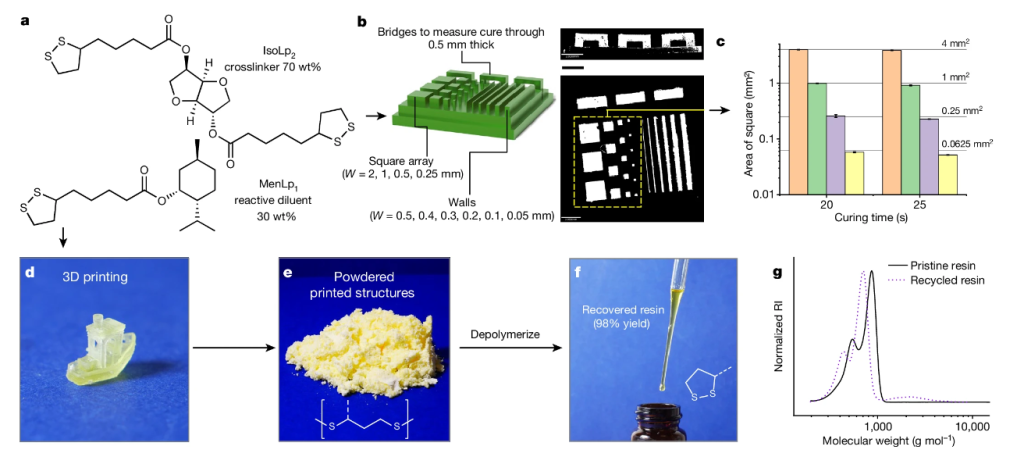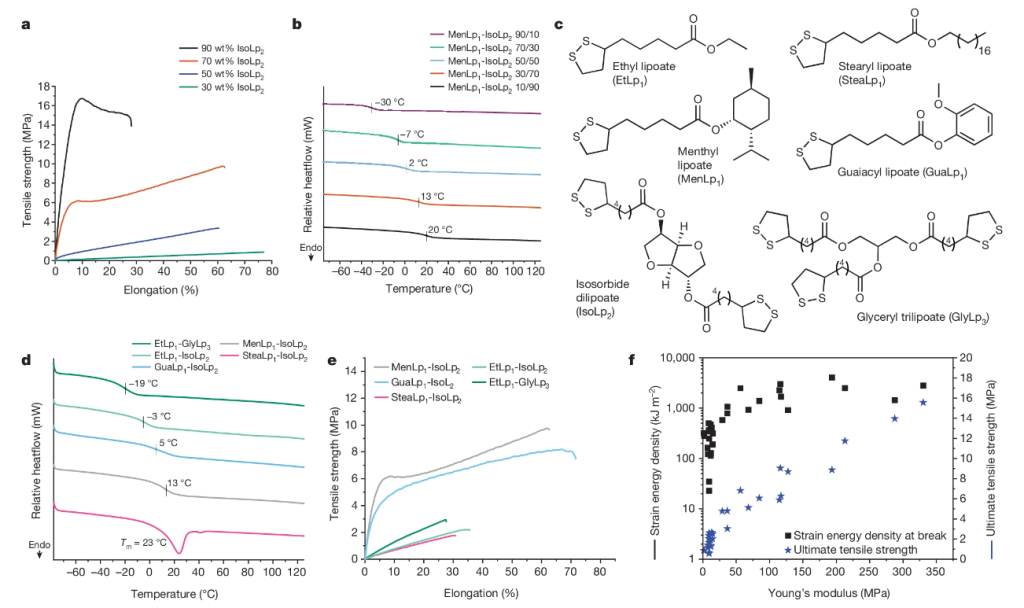Researchers from the University of Birmingham have introduced a new recyclable resin for 3D printing applications.
Detailed in a recent Nature publication, this development addresses a major sustainability hurdle in the industry. Traditionally, 3D printing relies on photopolymer resins derived from non-renewable petrochemicals like epoxies and acrylics. These materials, largely unchanged since the 1980s, pose a recycling challenge due to the irreversible chemical bonds formed during the curing process.
Lead researcher Professor Andrew Dove said, “Our approach is an important step away from relying on 3D printable resins made from petrochemicals, which cannot be efficiently recycled. While we still have improvements to make to the properties of the new resin, this research opens up exciting new avenues for development.”

Lipoic acid-based resin
Key to this achievement is the resin’s ability to be broken down into its building blocks (constituent parts) for reuse. This feat is accomplished by adding a minimal amount of photoinitiator, ensuring the material retains its curing properties. Notably, this approach avoids the “snowball effect” of traditional recycling, where additional chemicals are needed with each cycle.
At the core of this new resin is lipoic acid, a naturally occurring fatty acid commonly found in dietary supplements. The researchers cleverly synthesized a combination of two lipoic acid monomers, resulting in a resin that can be recycled back into these very monomers or even the original molecule itself. According to the team, this study demonstrates the successful completion of two recycling cycles, with the potential for even more in the future.
Looking ahead, this versatile material holds immense promise for various applications, particularly in industries that rely heavily on rapid prototyping – a crucial step for product testing before mass production. While the current formulation leans towards flexibility, future research could tailor the resin for diverse uses, from sturdy automotive parts and medical/dental components to intricate jewelry design.
Co-lead researcher Assistant Professor Josh Worch said, “Enabling recycling within the light-mediated 3D printing industry is essential since it is a rapidly expanding method for materials production. We now have the prospect, with our technology, to help ensure that recycling becomes a built-in feature of 3D printing.”
The University of Birmingham Enterprise has filed a patent application covering the resin and its use in AM applications.

Sustainable AM materials
Innovations in 3D printing materials are increasingly focusing on sustainability, aiming to minimize environmental impact by lowering carbon footprints, improving resource efficiency, and promoting circular economy practices. These materials also prioritize safety, and ensure the long-term viability of AM technologies in response to the growing global demand for eco-friendly solutions.
Back in 2020, researchers from Vilnius University and Kaunas University of Technology developed a recyclable bio-resin derived from soybeans for Optical 3D printing (O3P). This eco-friendly material met the technological and functional standards of conventional 3D printing polymers, offering enhanced biocompatibility at a lower cost.
By utilizing soybean extracts, the resin supported small batch production services and aimed to shift O3DP manufacturing towards sustainable practices, replacing non-recyclable petroleum-based photopolymers. The research highlighted the resin’s versatility across nano to macro dimensions and its potential to streamline eco-friendly additive manufacturing processes.
In another news, Massachusetts Institute of Technology (MIT) researchers developed a novel plant-derived 3D printable composite, by combining synthetic plastic with cellulose nanocrystals (CNCs) sourced from plant life. This material features a reinforced structure similar to a mollusk’s inner shell, enhanced by CNC content reaching up to 90%.
It boasts mechanical properties surpassing some bones and typical aluminum, while significantly reducing petroleum-based content. This innovation holds the potential to improve sustainable 3D printing and casting processes, potentially enabling new applications from dental implants to large-scale eco-friendly components.
Join the Expert Committee for the 2024 3D Printing Industry Awards to help select the winners!
What 3D printing trends do the industry leaders anticipate this year?
What does the Future of 3D printing hold for the next 10 years?
To stay up to date with the latest 3D printing news, don’t forget to subscribe to the 3D Printing Industry newsletter or follow us on Twitter, or like our page on Facebook.
While you’re here, why not subscribe to our Youtube channel? Featuring discussion, debriefs, video shorts, and webinar replays.
Featured image shows 3D printing of MenLp1–IsoLp2 (30:70 wt%) and depolymerization of printed parts. Image via University of Birmingham.



